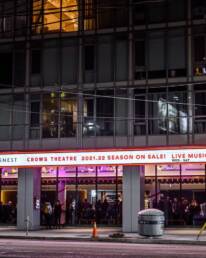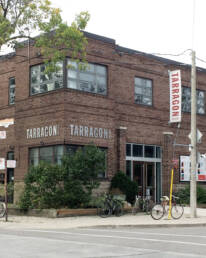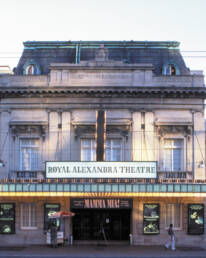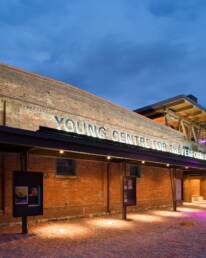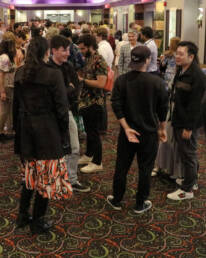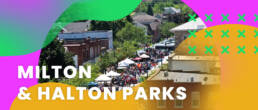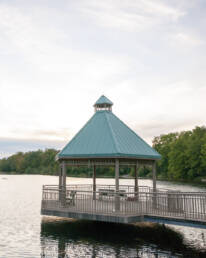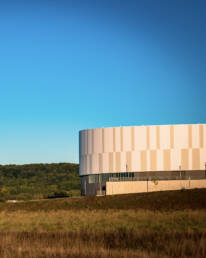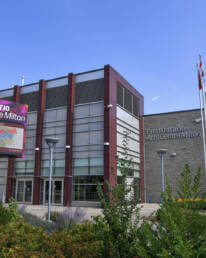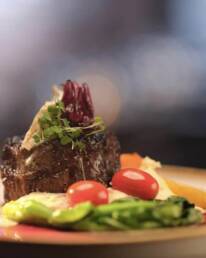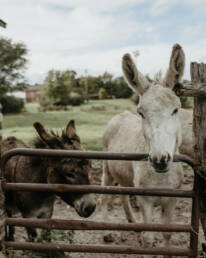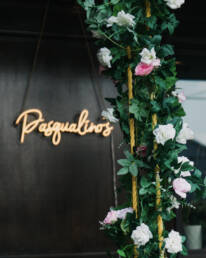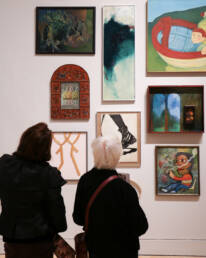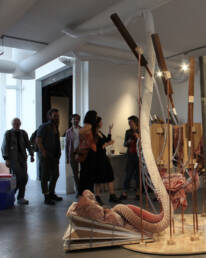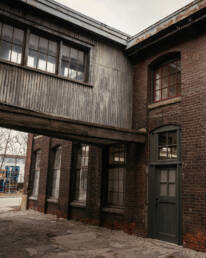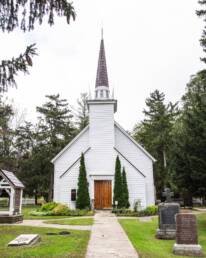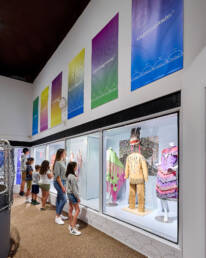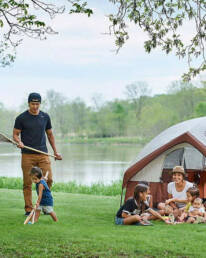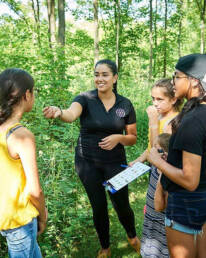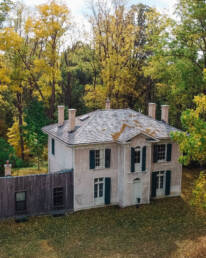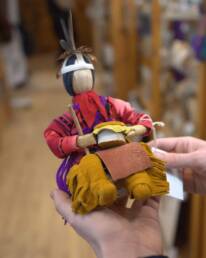Toronto Theatre Guide
February 27, 2024 | Photo: Buddies in Bad Times Theatre. Photo by Henry Chan.
Toronto Theatre Guide
Toronto contains the third largest English-speaking theatre district in the world, after London’s West End and New York City’s Broadway. But how do you navigate it? Here, to get you started, are five theatres, and their neighbourhoods, that deserve standing ovations.
BUDDIES IN BAD TIMES THEATRE
CHURCH WELLESLEY VILLAGE
Founded in 1979, Buddies is the largest and the longest-running queer theatre in the world. Just as the LGBTQ2S+ community has grown and diversified, so too has the theatre’s programming, which has included some of the earliest plays by co-founder Sky Gilbert, Daniel MacIvor, Ann-Marie MacDonald, Tawiah M’Carthy and Laakkuluk Williamson Bathory. Collaborations with Obsidian, the city’s leading Black theatre company, and the Indigenous-led Native Earth Performing Arts, have showcased the range of queer and experimental work.
The theatre’s position in the Church Wellesley Village means queer history, and helpful resources, are just steps away. Among the places to see are the 519 Community Centre, the AIDS memorial and Glad Day Bookshop. The latter is one of the few remaining queer bookstores in the world, and besides being able to find scripts of some of the plays that debuted at Buddies, you’ll also find poetry and comedy events, as well as the always popular drag brunch. With all that going on, it’s “Shantay, you stay” – in the neighbourhood – after attending something at Buddies.
CROW'S THEATRE
LESLIEVILLE
For the longest time, Toronto theatre was centred in the west end. But with the 2017 launch of the $11-million theatre complex at the base of a new condo in Leslieville, all of that changed. Under artistic director Chris Abraham, Crow’s, which had mounted shows at other venues for 25 years, has proved one of the most exciting artistic hubs in the city. And the company’s programming, which has included works by Michael Healey, Cliff Cardinal, Kristen Thomson and Hannah Moscovitch, remains unparalleled in terms of critical success and popularity.
Leslieville has become a hot spot for microbreweries, with places like Saulter Street Brewery and Eastbound Brewing Company providing the perfect backdrop to discuss the show you’ve just seen. And if you’re looking to chill out, two of the city’s nicest parks are within walking distance. Up the street is the beautifully maintained Withrow Park, and to the west is Broadview Park, which includes a view of the TO skyline so stunning you might be inspired to write your own play one day.
TARRAGON THEATRE
TARRAGON VILLAGE
The story of Canadian theatre would be incomplete without the Tarragon, founded in 1970 and long considered the premiere place to see new Canadian, and occasionally international, drama. Now-legendary plays like Kristen Thomson’s I, Claudia and Ted Dykstra and Richard Greenblatt’s 2 Pianos, 4 Hands began at the Tarragon, and for a time you could depend on seeing the latest by David French, Michel Tremblay (whose works were translated into English), Judith Thompson and Hannah Moscovitch there. Under new artistic director Mike Payette, the theatre has attempted to better represent the diversity of the city, with exciting results.
The theatre is so beloved, in fact, that the surrounding area has recently been branded Tarragon Village. Its distinguished neighbour to the north is the imposing, grand Casa Loma – a must visit for newcomers – as well as the less well known Spadina Museum. The eclectic, student-friendly Annex neighbourhood is a 10-minute walk south, and if you travel a few blocks west you’ll get to Christie Pits Park, which has enough history for a half dozen plays, as well as the delicious eateries of Koreatown.
ROYAL ALEXANDRA THEATRE
KING STREET WEST
Don’t be surprised if the elegance of this historic venue – opened in 1907, it’s the oldest continuously operating legitimate theatre in North America – upstages whatever show you’re about to see. Everyone from John Gielgud and Paul Robeson to the Marx Brothers and Edith Piaf have performed under its splendid proscenium stage. Before Canada had its own theatre industry, acts from the UK and the USA regularly performed here. They still do, of course, but some homegrown hits have also entertained audiences. Indigenous writer Tomson Highway’s Dry Lips Oughta Move to Kapuskasing made history in 1991 as the first Canadian play to get a full production here. More recently, the feel-good musical Come From Away played the Royal Alex before it transferred south, where it broke records as the longest-running Canadian musical in Broadway history.
Located in the heart of the entertainment district, other well-known venues – like the Princess of Wales Theatre, the TIFF Bell Lightbox and Roy Thomson Hall – are mere steps away. So are some of the city’s most scrumptious eateries and trendy bars. You can’t go wrong with PAI Northern Thai Kitchen, just around the corner. Although for pre-show dinners, make sure you tell your server the time of your play so you don’t create any unnecessary drama.
SOULPEPPER THEATRE
DISTILLERY DISTRICT
Founded in 1998 to mount lesser-known stage classics, Soulpepper moved to its current permanent space in the Distillery District in 2005, and quickly set about changing the city’s theatre landscape. Its Academy is one of the most prestigious and successful training hubs in the country – many of its graduates have gone on to lead theatres of their own. And Soulpepper has helped develop works like Ins Choi’s Kim’s Convenience, which went on to sitcom glory, as well as a series of sold-out cabarets and concerts.
A trip to a Soulpepper show wouldn’t be complete without a stroll through the atmospheric, brick-paved Distillery District, populated by galleries, boutiques, cafes and the distilleries and brew pubs that harken back to the area’s history. Cluny Bistro & Boulangerie is located a few steps away from the theatre, making it the perfect spot for pre- or post-show dining. If you’ve got a bit more time, you can venture east and check out Corktown Common, which includes a marsh, boardwalk and off-leash dog park. Nearby is the infamous Cube House and the Underpass Skatepark, which in addition to giving skaters a place to strut their stuff also displays some of the most colourful and inventive graffiti in the city.
YOUR TRIP AT A GLANCE
SEE & DO
519 Community Centre
AIDS Memorial
Buddies in Bad Times
Broadview Park
Casa Loma
Crow’s Theatre
Native Earth Performing Arts
Obsidian Theatre Company
Princess of Wales Theatre
Roy Thomson Hall
Royal Alexandra Theatre
Soulpepper Theatre
Spadina Museum
TIFF Bell Lightbox
Underpass Skatepark
Withrow Park
NEED A MAP?
This guide represents a weekend-long experience, highlighting one of the many wonderful destinations in the area. To suggest a destination for a future guide, please contact us.
Ontario Culture Days thanks Destination Toronto and Toronto Alliance for the Performing Arts for their support and assistance with this ON Culture Guide to Toronto Theatre. All editorial decisions were made at the sole discretion of Ontario Culture Days staff.
This guide was written by Glenn Sumi.
Oakville
Aug 31, 2023 | Photo courtesy of Oakville Museum
Oakville
Oakville’s gracious lakeside charm makes it one of Ontario’s most sought-after spots to call home. At an easy 30 kilometres from Toronto, it’s an ideal destination for visitors too – both for its waterfront beauty and its history as an industrial port and stop along the Underground Railroad. Located on the treaty lands and territory of the Mississaugas of the Credit First Nation, you may notice treaty lands signs as you wander, all part of Debwewin: the Oakville Truth Project, aimed at recognizing the area’s Indigenous past.
Day One
MORNINGDOWNTOWN, KERR VILLAGE AND OAKVILLE GALLERIES
CHARM AND SOPHISTICATION
Small-town feel meets big-city sophistication in Oakville, making downtown an appealing place to linger. Your only challenge will be which cafés to include in that quest! A couple of local favourites are Croissant Express Bakery (known for amazing croissants) and the cozy Tribeca Coffee Company. Or you could detour to eclectic Kerr Village, a pebble’s throw from the lake and home to the popular Vereda Central Coffee Roasters (where coffee is a “delicious science”). Brunch lovers note: Kerr Street Café is much beloved for its brunches.
The Oakville BIA’s signature events, including Hometown Holiday and Taste of Oakville, along with their street sales and local gatherings, cultivate a strong neighborhood spirit. Upscale fashion shopping is also a big thing in Oakville, from European-sourced styles at Must Boutique to beautiful, affordable clothing at Luxfindz and Second Chance’s consignment discoveries, among other spots. Shopping for art is a thing too, with many private galleries. To discover the works of emerging and established artists, visit Towne Square Gallery or Summer and Grace Gallery. For the work of Indigenous artists, there’s Native Art Gallery, and for contemporary art, Prometheus Art Gallery. When in Kerr Village don’t miss Rumi Galleries, where you’ll find modern art by British and North American masters.
From private to public: Oakville Galleries has two sites: downtown in Centennial Square and in serene Gairloch Gardens on the lake. The latter is housed in a cottage once owned by Toronto investment banker James Gairdner, who willed his residence and grounds for use as a contemporary gallery and public park. Today, this intimate art gallery seeks to connect people through art of our own times. To that end, it hosts workshops, art talks and art-in-the-park tours in addition to rotating exhibitions.
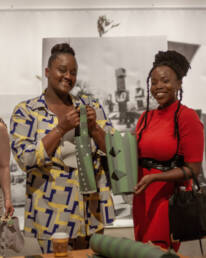

AFTERNOONOAKVILLE MUSEUM; TANNERY AND WATERWORKS PARKS
LOCAL HISTORY REVEALED
Another prominent historical estate-turned-museum in Oakville is Erchless Estate, one-time home of Oakville’s founding family, the Chisholms. The main house, Erchless (pronounced “erkless,” meaning “by the stream” in Scottish Gaelic), is where the museum resides. Among other things, it is notable for two permanent exhibitions devoted to Oakville’s Black history: “Freedom, Opportunity and Family,” sharing the stories of African-American families who made Oakville home, and the multimedia exhibit “The Underground Railroad — Next Stop Freedom!” narrated by the ghost of Deborah Brown telling the true story of her flight from slavery. The estate is also home to Oakville’s Old Post Office Museum, built in 1835, and in the summer you can take a tour and try your hand at postal-related fun like writing with a quill pen.
Tannery and Waterworks Parks are adjacent green spaces to stroll and enjoy fabulous views of Lake Ontario from the observation deck. In Tannery, you may notice a stone gathering circle decorated with images of moccasins. It’s part of the Moccasin Identifier project, an outdoor classroom providing school children with a chance to learn about the area’s rich Indigenous history. All ages have the opportunity to learn at the First Nations History Wall, located along the park’s shore.
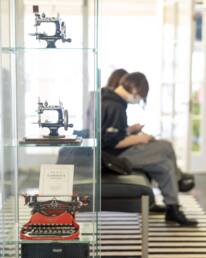
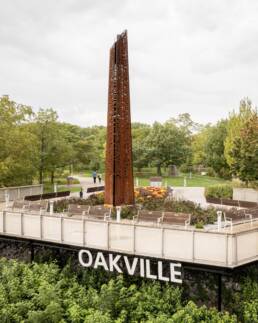
EVENINGOAKVILLE CENTRE FOR THE PERFORMING ARTS
EXCEPTIONAL DINING AND ENTERTAINING PERFORMANCES
Oakville has been called “foodie harbour” with good reason — there’s no shortage of dining options both downtown and in Kerr Village. Popular spots are Maro’s Bistro, for “reimagined” Mediterranean food; Community Restaurant for plant-based cuisine; Hexagon (listed among Canada’s 100 Best Restaurants) for stylish French food; and The Mermaid and the Oyster for seafood.
For a post-dinner treat, check out the Oakville Centre for the Performing Arts, known for presenting a variety of performances from dance to circus arts to storytelling to concerts. Its snappy slogan, “Small theatre big names” is accurate — over the course of a year, the centre presents 70 plus professional performances. But there are also hundreds of shows by local performers, making the centre a vital part of Oakville’s cultural community.
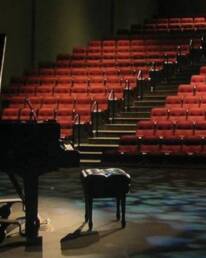
Day Two
MORNINGBRONTE VILLAGE, CORONATION AND BRONTE HERITAGE WATERFRONT PARKS, AND QUEEN ELIZABETH PARK COMMUNITY AND CULTURAL CENTRE
SHAPED BY WATER
Bronte Village, like its neighbour old Oakville, is shaped by water. For centuries, Indigenous inhabitants turned to the creeks and lake for travel and nourishment. Settlers built a busy port that saw shipbuilding, fishing and stonehooking industries — stonehooking being the tough work of gathering stone slabs from shallow waters for construction. By the mid-twentieth century, Bronte Harbour was best known for its recreational pleasures, as is true today. Consider a free walking tour via the Bronte Historical Society and visit the society’s home in the 19th century Sovereign House to learn more. Fishing folk note: you can still angle at both Bronte and Sixteen Mile Creeks or take charters in the harbour.
Bronte is also a perfect place to just slow down, perhaps with a picnic at family-oriented Coronation Park with its play areas and long beach. Bronte Heritage Waterfront Park is another spot to laze, with a wonderful vantage for admiring the harbour. Or get active by partaking in some of the many cultural events in the park — from birding lessons to bucket drumming workshops. And take a moment at the Bronte Commercial Fishermen’s Memorial, honouring those who set out in all kinds of weather to bring fish to markets from Toronto to New York City. Nearby Queen Elizabeth Park Community and Cultural Centre is a cultural hub worth checking out – hosting public art exhibitions, events, workshops and more, including a number of Ontario Culture Days events.
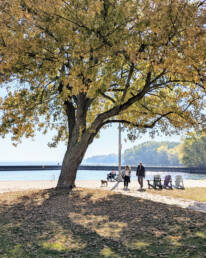
AFTERNOONLION’S VALLEY PARK AND JOSHUA CREEK HERITAGE CENTRE
GO NORTH
People love being by the lake, understandably. But don’t miss out on North Oakville as it too has much to offer — for instance Lion’s Valley Park, terrific for hiking and cycling (and gorgeous in autumn). Follow the Moccasin Trail to learn about the land from an Indigenous viewpoint as signs along the trail share stories relating to land, water and sky.
A 15-minute drive north brings you to the artist-run Joshua Creek Heritage Art Centre, a gallery ensconced in an 1827 barn amidst lovely gardens. The centre hosts arts programs and exhibits and prides itself on being something of a sanctuary from busy urban life. One way of exploring the sanctuary is by walking a labyrinth made of prairie grasses, bringing together the centre’s three pillars: art, wellness, and conservation. (Make sure to book labyrinth walks in advance.)
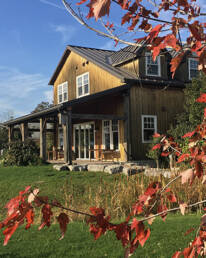
EVENINGFILM.CA AND 5 DRIVE-IN
DINNER AND A MOVIE
Why not make Bronte Village your stop for a leisurely dinner? A few choice spots include Por Vida Mezcal and Mexican, celebrating Mexican food and culture (and Mezcal!), The Bronte Boathouse with lake views, and Bronte’s Fish and Chips, serving customers for fifty years. Next, take a short drive to Film.ca Cinema, home to new movies at low prices. Film.ca Cinema is also the primary venue for the annual Oakville Festivals of Film and Art and runs classes for budding young filmmakers through the Film.ca Academy — making it another Oakville cultural institution. Or, cap off the evening with some retro-style entertainment at the 5 Drive-In Theatre, where you can ‘jump in your car and come as you are.’
YOUR TRIP AT A GLANCE
NEED A MAP?
This guide represents a weekend-long experience, highlighting one of the many wonderful destinations in the area. To suggest a destination for a future guide, please contact us.
All editorial decisions were made at the sole discretion of Ontario Culture Days staff. This guide was written by Li Robbins.
Milton
April 1, 2023 | Photo courtesy of Conservation Halton
MILTON & HALTON PARKS
Milton is a pedestrian-friendly blend of modernity and historic charm surrounded by the beautiful backdrop of the Niagara Escarpment — the best of both worlds. The town is a rich cultural blend too, with a blossoming South Asian-Canadian population. Arts events reflect Milton’s ever-increasing diversity, from Milton Culture Days to Summer Days/Summer Nights.
Day One
MORNINGTHE MILL POND; MATTAMY NATIONAL CYCLING CENTRE
TWO GREAT WAYS TO START YOUR DAY
Before you get moving, consider accepting WildFlour Bakery’s invitation to “come for a coffee, stay for the pastries,” to enjoy some of their Portuguese specialties. Other appealing options include the espresso bar within the Butcher Bar and classic breakfasts at Grill Daddy. A Saturday morning stroll downtown throughout the summer months affords you time to engage with local farmers and artisans selling their wares at the Milton Farmers Market.
Next, head to the Mill Pond, a freshwater reserve that once powered a gristmill and now delights walkers (and sitters). An easy two-and-a-half kilometre loop takes you by a gazebo, an old Canadian National Railway bridge and John Sproat House, built in Georgian style in 1857. (Trivia buffs note — it was once home to P.L. Robertson, inventor of the Robertson Head Screw.)
AFTEROONDOWNTOWN MILTON
SHOP, SNACK, STROLL
The eye-catching mural at Main and Charles, painted by two up-and-coming artists, welcomes all to enjoy Milton’s local arts, culture (and shopping!) scene. The Barn Door Studio & Café, as well as Muse Studio & Market, both sell work from local creatives and offer workshops where you can make all manner of useful items from plant stands to dog leash holders. Textile lovers will want to browse Oh Look, Fabric! with its notable selection of modern fabrics and handmade gifts.
On select Saturdays, wander through Milton’s Farmers’ Market, an enticing fresh-air marketplace brimming with local produce and products. There aren’t too many downtowns that lay claim to an operating blacksmith shop, but Milton is one. The Waldie Blacksmith Shop is one of the oldest shops of its kind in the province that’s still in its original location. Watch experienced blacksmiths at work or book your own smithing session. Check ahead for hours and reservations.
If afternoon brings a sweet craving, you’re in luck. Milton boasts not one but two indie ice cream spots: Rock Star Ice Cream and Jay’s Ice Cream & Sunshine’s Gelato. Or, if you want sweetness picked from the tree take a ten-minute trip to Chudleigh’s Apple Farm for apple picking and orchard treks, maybe catching a summer music concert while you’re there. Not apple season? Not a problem. Savour the farm’s famous apple treats all year round at Chudleigh’s Blossom Café right downtown.
EVENINGFIRSTONTARIO ARTS CENTRE MILTON
INSPIRED BY NATURE, CREATED FOR PERFORMANCE
Bright and airy, the FirstOntario Arts Centre Milton is an interdisciplinary arts venue that hosts a wide range of performances. Enjoy an evening of live music – from folk to the local Philharmonic – or take in a lively lecture series, film forum, or hands-on workshop.
The venue itself is inspired by Milton’s natural surroundings, with limestone, wood finishes and glass reflecting themes of water, agriculture, and the escarpment. If you’re intrigued by the design, consider booking a behind-the-scenes tour to learn more and to get a peek at the stage, green room and the Holcim Gallery with its visual arts exhibitions.
Pair your visit to the arts centre with a fine dining experience at Marquee Steakhouse. The Marquee hosts the region’s talented musical artists in their newly designed second-floor piano lounge. Enjoy live music with your meal inside or outside on their rooftop patio – which boasts an urban garden where the chefs grow vegetables and herbs to be included in their spring, summer and autumn menus.
Day Two
MORNINGCONSERVATION HALTON PARKS
A WORLD OF GREEN SPACES
You’d be hard-pressed to pick just one conservation area to visit near Milton. The region is home to half a dozen gorgeous spots, where you can hike, bike, rock climb, ski, golf and more. First, fuel up at the aptly named Trail Eatery in Campbellville. Then, noting that reservations are required to visit some conservation areas, you’re spoiled for choice. Crawford Lake Conservation Area features a stroller-friendly boardwalk dotted with wood carvings, as well as cross-country ski and snowshoe trails. It’s also home to the Longhouse Village, with three reconstructed fifteenth-century longhouses and the Three Sisters and Mashkiki Gitigan (medicine garden), a window into Indigenous agriculture and the lives of the meromictic lake’s original residents.
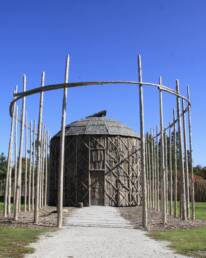
In winter, Kelso Conservation Area is where you’ll find skiing and snowboarding (at Glen Eden); in other seasons you can hike, bike, paddle or swim. Hilton Falls features beautiful waterfalls; Mount Nemo is famed for impressive biodiversity plus a stunning escarpment lookout; and Mountsberg is home to both a raptor centre and an animal barn.
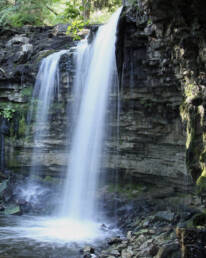
AFTERNOONHALTON COUNTY RADIAL RAILWAY MUSEUM
RIDE THE RAILS
It all began in 1954 with a Toronto Transit Commission streetcar saved from the scrap yard by a group of devoted railcar fans. Today, adults and kids alike enjoy Ontario’s largest electric railway museum with its historic railcars that operate on two kilometers of scenic track. The museum has an impressive collection as well, featuring vintage streetcars, locomotives, and buses, many of which you can explore inside. Plus, the museum houses various other rail-related paraphernalia. No wonder it’s also been featured as a backdrop for film and TV productions, including Anne of Green Gables — it’s a sweet spot. It’s open seasonally, so check ahead.
AFTERNOONCOUNTRY HERITAGE PARK
THE RURAL URBAN CONNECTION
Country Heritage Park makes the connection between rural and urban, farming and food. It’s home to some beautiful 19th century buildings, including a church, a townhall and a schoolhouse. The park runs events of all kinds from craft fairs to truck pulls, as well as selling farm-fresh products. Make time to visit the garden created in conjunction with Grandmother’s Voice (an organization dedicated to sharing the wisdom of Indigenous grandmothers, elders and knowledge holders). The healing garden can be entered from all four directions and holds over thirty species of native plants.
EVENINGTIME TO DINE
FROM SOUTH ASIAN TO STEAKHOUSE
Milton’s dining choices include some very tasty South Asian cuisine — no surprise given South Asian residents represent close to thirty per cent of the town’s population. Options include buffet style at Bombay Grill, Pakistani dishes at Spice Fusion and naan at Naan Guys. There’s also fine dining of many cultures to be found, including gourmet Indian cuisine at Chef Sanjeev Kapoor’s Khazana and Italian at Pasqualino (cooking classes also on offer). Feel more like pubbing? For a small city, Milton is replete with pubs, including the Ivy Arms, Rad Brothers Sports Bar & Tap House, Ned Devine’s Irish Pub and Bryden’s Pub & Restaurant. Ask for a local craft beer made by Orange Snail or Third Moon – or simply head straight to the breweries themselves to taste the brews in their original habitat.
YOUR TRIP AT A GLANCE
SEE & DO
Chudleigh’s Apple Farm
Country Heritage Park
Crawford Lake Conservation Area
Mural At Main And Charles
FirstOntario Arts Centre Milton
Grandmother’s Voice
Halton County Radial Railway Museum
Hilton Falls
Holcim Gallery
John Sproat House
Kelso Conservation Area
Mattamy National Cycling Centre
Mount Nemo
Mountsberg
Muse Studio & Market
Oh Look, Fabric
Three Sisters And Mashkiki Gitigan
Waldie Blacksmith Shop
EAT & DRINK
Barn Door Studio & Café
Butcher Bar
Bombay Grill
Bryden’s Pub & Restaurant
Coffee Culture Café & Eatery
Grill Daddy
Ivy Arms
Jay’s Ice Cream & Sunshine’s Gelato
Khazana
Marquee Steakhouse & Piano Lounge
Milton Farmers’ Market
Naan Guys
Ned Devine’s Irish Pub
Orange Snail Brewers
Pasqualino
Rad Brothers Sports Bar & Tap House
Rock Star Ice Cream
Spice Fusion
Third Moon Brewing
Trail Eatery
WildFlour Bakery
YOUR TRIP AT A GLANCE
This guide represents a weekend-long experience, highlighting one of the many wonderful destinations in the area. To suggest a destination for a future guide, please contact us.
Ontario Culture Days thanks its tourism partner the Town of Milton for their support and assistance with this article. All editorial decisions were made at the sole discretion of Ontario Culture Days staff. This guide was written by Li Robbins.
Hamilton
January 25, 2023 | Photo Courtesy of Art Gallery of Hamilton
HAMILTON
Some say “art is the new steel” in Hamilton. It’s no wonder — the city best known for its industrial side has become a thriving arts destination for artists and visitors alike. And with easy access from Toronto and Niagara Falls, Hamilton is ideal for a day trip…or two.
Day One
MORNINGCOOL CAFES; ART GALLERY OF HAMILTON
SIMPLY IMPRESSIVE
Kickstart your day at a cheery café, of which Hamilton has an abundance. Coffee lovers will be pleased to discover the town where Tim Hortons was born is also home to a plethora of indies. Several are conveniently close to the Art Gallery of Hamilton, including Mulberry Coffeehouse, Redchurch Café + Gallery, and Ark + Anchor Espresso Bar. The AGH itself is the oldest, largest art museum in the region, home to an impressive permanent collection. You’ll find striking pieces by Alex Colville, the Group of Seven, Emily Carr and, notably, Norval Morrisseau. The Morrisseau works represent one of the largest public collections of the influential artist’s paintings, whose ground-breaking style is famous for highlighting the rich culture of the Anishinaabe peoples of Turtle Island.
AFTERNOONJAMES STREET NORTH
BIRTHPLACE OF “ART IS THE NEW STEEL”
It’s one of the oldest streets in Canada with a history of “firsts” for Hamilton. First department store (The Right House), first skyscraper (Pigott Building) and first indoor mall (Lister Block). Today, James Street North is one of the first places to go for restaurants and galleries. The early 21st-century arts renaissance (which led to the slogan “art is the new steel”) has spread throughout the city now. But James North is still home to the popular Art Crawl pop-up event each month, plus permanent galleries including You and Me Gallery, and Hamilton Artists Inc. Also consider checking out artist-run co-op The Assembly on King although note — it’s open “by chance or by appointment.” That said, nearby Redchurch Café + Gallery has its own dedicated art space curated in partnership with The Assembly.
AFTERNOONURBAN MURAL WALKS
A PAINTED CITY
Hamilton has rightfully been called a city of murals, and you’ll see the vibrant public art form everywhere, including James Street North, Burlington, and Mary streets, and features a significant amount of eye-catching work by sought-after Haudenosaunee artist, Kyle Joedicke. Cyclists may choose to explore the one-hundred-plus murals on two wheels, thanks to the Hamilton Bike Share’s “Everyone Rides” initiative Mural Map. And July’s Concrete Canvas Art Festival gives one and all a chance to watch mural artists in the act of creation. Next on your plate could be some excellent dining, since Hamilton’s growing reputation as a creative culinary hotspot makes for many possibilities. To name a few: Mexican cuisine at The Mule, Italian at Born and Raised (home to Top Chef Canada finalist Vittorio Colacitti), pub food at Odds Bar (founded by two members of the band Arkells) and vegan cuisine at Democracy*.
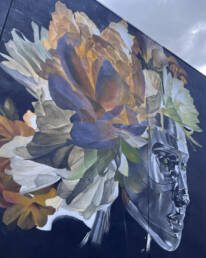
EVENINGMUSICTOWN
FROM PUNK TO JAZZ TO CLASSICAL
Seems like every few years there’s another article about Hamilton’s music scene blowing up. Not a surprise, given the city is the birthplace of bands like Arkells, Whitehorse and Monster Truck, and home to Daniel Lanois’ world-renowned Grant Avenue Studio. There’s even a TV show (“This Is The Thing”), based on fictional Hamilton musicians — showcasing actual Hamilton musicians and comedians. In September, James Street’s Art Crawl turns into Supercrawl, celebrating music alongside art. Plus, the ongoing scene runs the gamut from punk to jazz to classical. FirstOntario Concert Hall is home to the Hamilton Philharmonic Orchestra as well as presenting a range of concerts by touring artists. Mills Hardware is a cool live music space with a long history: acts like Ronnie Hawkins and The Hawks, The Ink Spots, The Tragically Hip and The Ramones have all played at the venue. Today, the programming crisscrosses music genres along with theatre, comedy and more. As for the thriving local scene, check out the beloved Casbah Lounge.
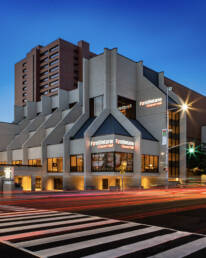
Day Two
MORNINGROYAL BOTANICAL GARDENS
WORLD’S LARGEST BOTANICAL GARDEN
Culture in Hamilton is growing — literally — at the Royal Botanical Gardens, just a few minutes’ drive from downtown. The world’s largest botanical garden has been described as “an interactive museum filled with natural wonders,” and so it is. With its 27-plus kilometres of trails, it’s a lovely place to visit any time of year. In season you’ll find the world’s largest lilac collection plus some 3,000 rose bushes, among other floral splendours. The RBG is also a choice lunch stop, given the Greenhouse Café specializes in local produce and Ontario wines and craft brews. The birthplace of the gardens is just a three-minute drive away at the Rock Garden, with its year-round perennial display that emphasizes sustainable trends in garden design in a heritage setting. Makes sense, considering Hamilton’s unique natural backdrop, with the Niagara Escarpment (nicknamed The Mountain) dividing the city, and sparkling with 100-some waterfalls mere minutes from the downtown core.
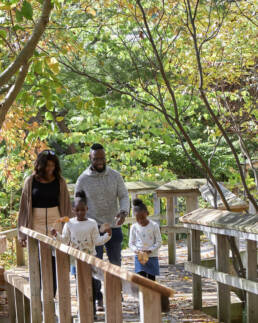
AFTERNOONDUNDAS ARTS STUDIOS
THE VALLEY TOWN
Stop in lovely little Dundas on your way back downtown. The “Valley Town,” as Dundas is known, is a true sweet spot: its historic 19th-century centre is dotted with boutiques and cafés and surrounded by green space. (Not to mention it has the distinction of hosting the annual Cactus Festival, which has led some to call Dundas the “cactus capital of the universe.”) Dundas also has a thriving visual arts scene, with the Dundas Valley School of Art, Millworks Creative’s community of artists, and a bustling annual studio tour each fall. Permanent galleries include The Carnegie Gallery, with exhibitions by contemporary Canadian artists (and arts and crafts by locals on offer), plus Danuta Niton — Art of Design Studio, and Lorraine Roy Art Textiles.
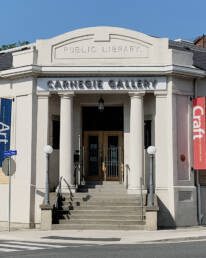
AFTERNOONCOTTON FACTORY
COOL, GRITTY…AND CHARMING
From cotton mill to creative hub, welcome to The Cotton Factory. Back in 1900, Hamilton was on the verge of an economic boom that made its steel famous, but textiles played their part too, notably the Imperial Cotton Company’s canvas manufacturing. Today, the charming old building has been repurposed as a centre for artists of all kinds (furniture designers, photographers, musicians, filmmakers etc.) to create and collaborate. Art experiences, markets and open studio days are regular features, with some studios selling the work of local makers. Located in a cool, gritty, and evolving part of Hamilton you’ll also find interesting spots to dine not far away. For instance, Motel Restaurant’s hipster brunches, Mosaic (“a chill bar with a warm vibe”), the Galley Pump’s hometown comfort food, and O Leão Cafe & Restaurant’s Portuguese cuisine.
EVENINGTHEATRE AQUARIUS; PLAYHOUSE CINEMA
STAGE AND SCREEN
Theatre Aquarius is known for producing high-quality work and for its interest in bringing new plays to the stage. In other words, the name Theatre Aquarius is synonymous with accessible, challenging, and entertaining live theatre. But it also serves as a vibrant part of Hamilton’s arts community through theatre arts education for young people of diverse backgrounds, and with Indigenous, newcomers, and LGBTQ+ outreach programs. Note too that Hamilton offers a theatre experience of the filmic kind at the Playhouse Cinema, where you can enjoy all manner of movies in a restored and beautiful theatre dating back 105 years.
YOUR TRIP AT A GLANCE
SEE
Art Gallery of Hamilton
The Assembly Gallery
Carnegie Gallery
Casbah Lounge
Concrete Canvas Art Festival
The Cotton Factory
Danuta Niton — Art of Design Studio
Dundas Studio Tour
Dundas Valley School of Art
FirstOntario Concert Hall
Grant Avenue Studio
Hamilton Art Crawl
Hamilton Artists Inc.
Hamilton Mural Map
Lorraine Roy Art Textiles
Mills Hardware
Millworks Creative
Pigott Building
Playhouse Cinema
The Right House
Royal Botanical Gardens
Supercrawl
Theatre Aquarius
You and Me Gallery
YOUR TRIP AT A GLANCE
This guide represents a weekend-long experience, highlighting one of the many wonderful destinations in the area. To suggest a destination for a future guide, please contact us.
Ontario Culture Days thanks its tourism partner THE HEART OF ONTARIO for their support and assistance with this article. All editorial decisions were made at the sole discretion of Ontario Culture Days staff. This guide was written by Li Robbins.
Six Nations of the Grand River
November 15, 2022 | Photo courtesy of Six Nations Tourism
Six Nations of the Grand River
Located south of Brantford and running alongside the Grand River, this southwestern territory in Ontario is brimming with history that spans thousands of years. The Six Nations of the Grand River is the only region in the continent where all Haudenosaunee nations live together. The Haudenosaunee Confederacy (which translates to “they build houses”) is made up of the Mohawk, Cayuga, Onondaga, Oneida, Seneca and Tuscarora nations. Together they contribute to the area’s rich arts, natural elements, history, and ongoing legacy.
Day One
MORNINGHER MAJESTY’S ROYAL CHAPEL OF THE MOHAWKS
BEYOND THE STAINED GLASS WINDOWS
When you first arrive at Her Majesty’s Royal Chapel of the Mohawks, you’ll see a quaint building with eight beautiful stained-glass windows. But beyond the infrastructure and picturesque nature surrounding the area lies a history that spans 300 years. Built in 1785, it’s the oldest surviving church in Ontario. The Chapel offers workshops and guided walking tours for visitors to learn more about the history of the Six Nations and its relationship with settler Canada. You can learn more through talks led by community members on this complex history as well as perspectives on reconciliation from Six Nations community members.
AFTERNOONMOHAWK INSTITUTE RESIDENTIAL SCHOOL AND THE WOODLAND CULTURAL CENTRE
LEARNING ABOUT RECONCILIATION
Delve deeper into important history through the Mohawk Institute Residential School and the Woodland Cultural Centre. The Centre was established in 1972 after the closure of the residential school. It is now one of the most extensive facilities in Canada managed by First Nations, with over 50,000 artifacts in its collection and a library of Indigenous-only books, research, and more. Want to learn more? Book a Truth and Reconciliation presentation to further understand the latest progress report and the Truth and Reconciliation Commission’s 10 Principles and 94 Calls to Action. The Centre also offers virtual tours of the former Mohawk Institute Residential School, which was in session for 140 years.
Next, visit the locally-owned Burger Barn for lunch. The restaurant is known for having the ultimate comfort food with huge portions. The restaurant – which looks like a barn from the outside —boasts fresh 8oz ground patties and a variety of styled burgers that have toppings like macaroni and cheese and pulled pork.
AFTERNOONKAYANASE GREENHOUSE
A HORTICULTURAL TOUR
Now 15 years old, Kayanase Greenhouse is dedicated to restoring the remaining nature after the construction of the Red Hill Valley Parkway. It’s the perfect spot to learn more about ecological restoration and traditional harvesting and planting methods. The greenhouse offers native plants and seeds to purchase, such as wild bergamots and tree saplings. This area is open seasonally, so be mindful of this when you visit.
EVENINGCHIEFSWOOD PARK
A DAY OF PLAY
Right next door to Kayanase is Chiefswood Park, known for its forest trails, historical exhibits and outdoor activities. Secure a full- or half-day experience to learn about Haudenosaunee culture and art. Enjoy sports? Pick up the history of the iconic sport lacrosse, and play it too. Want to grasp how food is harvested traditionally? AR/VR experiences are available to learn about the Three Sisters. In the evening, end the day paddling or lounging at the Grand River. Did you know you can also spend the night at Chiefswood Park? Their accommodations range from different-sized cabins to tent camping or glamping in a Riverside Hut.
Day Two
MORNINGSIX NATIONS TRAIL
TAKING IN NATURE ON THE TRAIL
Explore the largest Carolinian forest in Southern Ontario while walking the Six Nations Trail. The trail is suitable for almost everyone and takes about 15 minutes to complete. A guided tour will help you learn more about the Indigenous plants in the area.
MORNINGCHIEFSWOOD NATIONAL HISTORIC SITE; YAWÉKON
AN ARTIST’S PARADISE AND TOP CHEF DISHES
Tour Chiefswood National Historic site, built in the mid-1800s for Chief George Johnson. The site is the birthplace of Indigenous poet, performer, and author E. Pauline Johnson, also known as Tekahionwake. Her poetry is recognized for its strong portrayal of Indigenous women and children. Some of her most notable poems include “A Cry from an Indian Wife,” about the Riel Rebellion, and “Ojitsoh,” about a Mohawk wife who is kidnapped by a Huron captor.
For lunch, try some Haudenosaunee cuisine at Yawékon by Tawnya Brant. Brant is a local chef and former competitor of Top Chef Canada. Yawékon means “it tastes good” in Mohawk, which is quite fitting for this special food spot. Brant likes to use ingredients she grew at home to make dishes like Three Sister soup, and blueberry and pan-seared Bay of Quinte Mohawk trout cakes.
AFTERNOONSIX NATIONS ARTISANS
HANDMADE JEWELRY, CRAFTS & MORE
Support Six Nations artisans by shopping locally. Sapling and Flint is named after the twin boys born to Skywoman’s daughter, according to the Ohswekén:’a Creation Story – a fitting name for a shop run by twin sisters! Their handmade jewelry is made of gold, wampum, and sterling silver. Proceeds contribute to cultural projects in Six Nations. Ribbon skirts, pants and plush reversible blankets can be found at GOTribalwear. Or visit I&S Crafts and Supplies for hand-made jewelry and Delica beading supplies.
Iroqrafts is the oldest and largest arts and crafts store in Six Nations, with plenty of goodies to choose from. You’ll find local creations including beadwork, soapstone sculptures, moccasins, and turtle shells. Authentic furs, fur hats, boots, hide, and leather goods are available to purchase as well.
EVENINGWINGS & BINGO
DINNER AND A GAME
End the day with a hearty dinner at Village Pizza and Wings. The restaurant is known for its — you guessed it — stone oven pizza and jumbo wings. The generous portions will not leave you hungry.
Next, test your luck and contribute to the community with Six Nations Bingo. Join matinee and evening sessions where you can win jackpot prizes in the thousands. Six Nations Bingo donates 40 per cent of its annual profits to educational community programs across the region.
YOUR TRIP AT A GLANCE
EAT & DRINK
NEED A MAP?
This guide represents a weekend-long experience, highlighting one of the many wonderful destinations in the area. To suggest a destination for a future guide, please contact us.
Ontario Culture Days thanks its tourism partners Six Nations Tourism and The Heart of Ontario for their support and assistance with this article. All editorial decisions were made at the sole discretion of Ontario Culture Days staff. This guide was written by Ramona Leitao.
Toronto Public Art
October 18, 2021 | Photo courtesy of Destination Ontario
Toronto Public Art
Toronto is a famously diverse cultural hub for all of Canada. Perhaps less known is just how extensive and exciting the city’s public artwork is. But with a new initiative, ArtworxTO: Toronto’s Year of Public Art 2021–2022, all that is changing.
Day One
MORNINGSLIDE BY GREAT GRAFFITI
HEAD TO THE HEART OF STREET ART IN GRAFFITI ALLEY
Toronto’s Graffiti Alley proves just how awesome street art can be. A ribbon of city alleyway hidden behind Queen Street West, (its proper name is Rush Lane), expect to see wildly colourful murals, some by well-known Toronto street artists. Perfect for photo ops!
Murals pop up everywhere in the city, for instance 2021’s Storytelling Mural on Central Hospital Lane in Cabbagetown (a half hour transit ride from Graffiti Alley). It’s the city’s first laneway “healing corridor,” with a series of Indigenous medicinal gardens and a mural based on Indigenous healing stories. It’s also part of The Laneway Project, transforming Toronto’s overlooked public spaces.
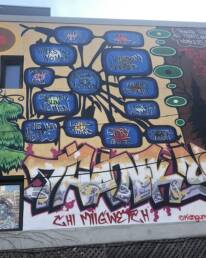
MORNINGWEND YOUR WAY THROUGH KENSINGTON
A FEAST FOR ALL SENSES IN KENSINGTON MARKET
Kensington Market is more than just a market, it’s a neighbourhood! A short walk north of Graffiti Alley, the market is on the traditional territory of the Haudenosaunee, the Mississaugas of the New Credit First Nation, and the Huron-Wendat. You may notice this history reflected in Queen Street’s other name, Ogimaa Mikana. It’s part of the The Ogimaa Mikana Project, aimed at restoring Anishinaabemowin place names to Toronto’s streets and byways.
The area first became a market in the early 1900s when Jewish immigrants moved into the area. That wave of migration also gave rise to the nearby fashion district, marked by artist Stephen Cruise’s giant thimble, “Uniform Measure/Stack,” at Spadina and Richmond.
Today the market is a rich tapestry of many cultures, a walkable, open-air marketplace filled with delectable produce; vintage clothing stores, and eclectic restaurants. One popular spot for live music is the restaurant/bar fittingly called Supermarket.
If you’re hankering for some of the best Chinese food anywhere, stroll a few minutes east to North America’s largest Chinatown. It’s a parade of fresh fruit, veggies and herbs, and its restaurants feature everything from delectable dim sum to delicious dumplings. (Mother’s Dumpling’s is one perennially popular spot.)
Of course, you could make a whole day of it in the Kensington-Chinatown area, for art as well as edibles. The Art Gallery of Ontario on Dundas Street is minutes away, and home to the famed Henry Moore Sculpture Centre. (To literally get into Moore’s work visit nearby Grange Park, and slide onto his famous “Large Two Forms” sculpture.) StrollTo’s guide to the neighbourhood will provide yet more reasons to linger longer.
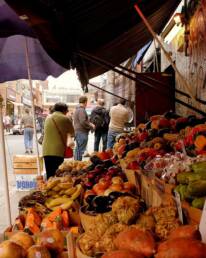
AFTERNOONROAM THE ROM
TAKE PHILOSOPHER’S WALK TO THE ROYAL ONTARIO MUSEUM
Take one of the city’s loveliest pathways — Philosopher’s Walk — which brings you through the University of Toronto, following the now-underground Taddle Creek. At Bloor Street round the corner east to the Royal Ontario Museum. The ROM is rightfully one of the most visited museums in Canada, with extensive galleries of art, world culture, and natural history. Delve into the Daphne Cockwell Gallery, a permanent exhibition dedicated to First Peoples art and culture. The exhibition contains more than one thousand works, from beautiful birchbark canoes to Lakota Sioux chief Sitting Bull’s war bonnet.
Bloor Street itself is home to Mink Mile, so named for an abundance of upscale shops. But the area is also a treasure trove of museums, art exhibitions and cultural centres, all within an easily walkable one mile (or via a quick subway hop). No wonder it’s been dubbed the Bloor Street Culture Corridor.
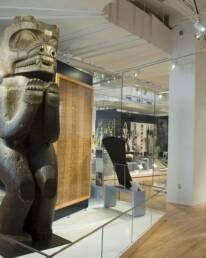
EVENINGSHOWTIME!
GET YOUR MUSIC FIX AT ICONIC KOERNER AND MASSEY HALLS
Two of the city’s finest concert halls are close to the ROM: the stunning Koerner (a three-minute walk), and legendary Massey (a twenty-minute subway ride). Koerner opened in 2009 to rave reviews for its acoustics and beauty. It showcases classical, jazz, pop and world music concerts of the highest order. The recently renovated Massey Hall dates back to 1894, and it’s seen an incredible list of artists perform centre stage, from Maria Callas to Bob Dylan to Glenn Gould to Bob Marley.
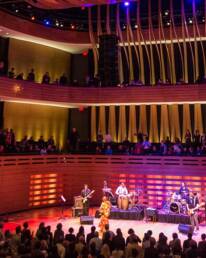
Day Two
MORNINGBEGIN BY THE LAKE
MEDITATE AT THE MUSIC GARDEN
The beguiling Toronto Music Garden makes for a tranquil, lakeside start to your day. The musical work that inspired it, Bach’s First Suite for Unaccompanied Cello, is reflected in the actual garden, with each movement corresponding to a different section.
From garden calm to city hustle and bustle — and colour, thanks to the Toronto Colour Walk, created by Toronto West BIA. Downtown buildings may trend grey, but splashes of artist-created colour bring the city to life. This self-guided walking tour takes you by a range of sculptures and murals, including two works by Douglas Coupland (yes, Generation X author Douglas Coupland): the playful “Bobber Plaza” and “Superior,” inspired by Group of Seven artist Lawren Harris’ painting “North Shore, Lake Superior, 1926.”
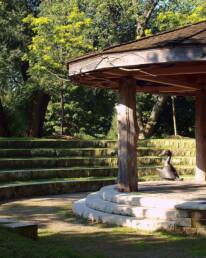
AFTERNOONLUNCH IN LESLIEVILLE
HISTORY AND HIPNESS, FROM THE DISTILLERY TO LESLIEVILLE
Stop 2: Head east to hip Leslieville, maybe with a stop en route at the Distillery District. There you can stroll the pedestrian-only enclave of restaurants, boutiques and galleries, all in striking former Victorian industrial buildings. On to Leslieville, so named after pioneering gardener George Leslie, whose 19th century nurseries spanned 150 acres. Artefacts from fields around Jones and Queen streets suggest that long before flowers and fruits Indigenous peoples camped in or near what’s now Leslie Grove Park. Today the area has a village feel, casual and fun, with plenty of options for foodies. Note: Take the streetcar from The Distillery to Leslieville to trundle over the Queen Street Bridge beneath by Eldon Garnet’s elegant art installation, “Time and a Clock.”
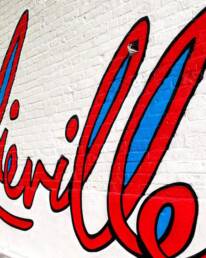
AFTERNOONWALK THE DON
WALK THE DON RAVINE FOR URBAN FOREST AND SCULPTURAL SURPRISES
Toronto is a city of ravines, a network of urban forest perfect for biking, walking and occasional glimpses of wild critters. Access the Lower Don Trail (a 4.7 kilometre walk along the Don River) at the Queen Street Bridge and head north. You’ll pass beneath the arched magnificence of the Prince Edward Viaduct (better known as the Bloor Viaduct, made famous by Michael Ondaatje’s In The Skin of a Lion). Next you’ll encounter “Monsters for Beauty, Permanence, and Individuality,” reconstructed copies of gargoyles from historic Toronto buildings. These striking sculptures were created by Omaskêko Cree artist Duane Linklater as part of the Don River Valley Park Art Program. Once you’re all walked out head up to The Danforth and Greektown for mouth-watering Greek specialties.

EVENINGCATCH A SHOW
TIME FOR SOME MUSIC…OR DANCE…OR THEATRE
Built as a movie theatre in 1919, the character-filled Danforth Music Hall hosts both local and international musicians. Home to smallish shows (capacity is roughly 1,400) it has a neighbourhood feel, bordered by leafy Riverdale. Or, if the play’s the thing, take a short streetcar ride south to Crow’s Theatre. Crow’s opened in 2017 in a sleek new complex complete with lobby bar. Since then, it’s quickly became a preeminent cultural destination with a penchant for inventive, fiercely contemporary (and frequently Canadian) work.
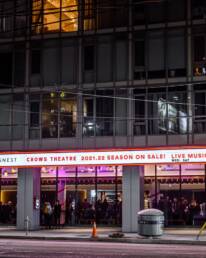
YOUR TRIP AT A GLANCE
SEE
Art Gallery of Ontario
ArtworxTO: Toronto’s Year of Public Art 2021–2022
Crows Theatre
Danforth Music Hall
Distillery District
Don River Valley Park Art Program
Duane Linklater, Monsters for Beauty, Permanence, and Individuality
Eldon Garnet, Time and a Clock
Grange Park
Greektown on the Danforth
Henry Moore, Large Two Forms
Koerner Hall
The Laneway Project
Massey Hall
The Ogimaa Mikana Project
ROM
Stephen Cruise,
Uniform Measure/Stack
Supermarket Bar
Toronto Music Garden
YOUR TRIP AT A GLANCE
This guide represents a weekend-long experience, highlighting one of the many wonderful destinations in the area. To suggest a destination for a future guide, please contact us.
All editorial decisions were made at the sole discretion of Ontario Culture Days staff. This guide was written by Li Robbins.
Halton Hills Region
Updated November 2022.
HALTON HILLS, GEORGETOWN AND GLEN WILLIAMS
Halton Hills is a community of towns, hamlets, and villages along the Niagara Escarpment, with the Credit River winding its way through the forests, plains, and marshes. The abundant natural beauty and small-town charm have captured the hearts of artists, encouraging many of them to call this place home.
Day One
MORNINGBIKE-FRIENDLY START TO YOUR DAY
DAY 1 – 10:00 AM: THE HALTON HILLS CULTURAL CENTRE HAS IT ALL
The Halton Hills Library and Cultural Centre has been designated a Bike Welcome Centre and has everything you need to tune up your ride and prepare for your tour. The John Elliot Theatre is in the same complex as the Helson Gallery, which places the old Congregational Church structure, with its vaulted ceilings and stained-glass windows, firmly in the present day. At the Helson Gallery, enjoy workshops, community art projects, and the latest work from local artists.
Stock up your bike basket with fresh produce, cheeses and breads from the local farmers market in downtown Georgetown. The farmers’ market runs Saturday mornings from June to October.
AFTERNOONRIDE DOWN HISTORIC GUELPH STREET
DAY 1 – 12:00 PM: A HISTORICAL STREET WITH SNACK AND EATS
Nineteenth-century history lives here at the crossroads of French Catholics and the Church of England. There’s St. John’s United (1840s with renovated gothic revival form), l’Eglise Sacré-Coeur (1885), and St. George’s Anglican Church (originally a wooden structure in 1833 before the sturdier stone structure replaced it in 1851).
If you’re hungry, you can do a coffee and snack crawl along your way to check out the best patios along the historic street. But save room because your next stop is perfect for a picnic.
AFTERNOONWANDER DOMINION GARDENS PARK
DAY 1 – 1:00 PM: ENJOY THE FRESH AIR IN DOMINION GARDENS PARK.
There’s a splash pad and a playground, but the Old Seed House Garden is the park’s main attraction. Entrepreneur William Bradley founded the garden in 1928, and within a decade, business was booming, with seeds sown from British Columbia to Newfoundland. Today, the area remains a tribute to its place in local history. The gazebo at the heart of the garden is a popular place to rest, with twin flowerbeds of tulips, daffodils, lilacs and forsythias surrounding the structure.
AFTERNOONVISIT THE GROUNDS OF HISTORIC DEVEREAUX HOUSE
DAY 1 – 2:30 PM: CUTTING ACROSS TOWN, YOU’LL COME ACROSS THIS PLEASANT VICTORIAN-ERA FARMHOUSE.
Though its surrounding farmland was established in 1829, it wasn’t until the 1850’s that Elijah Devereaux, a member of the local militia, constructed the house. Unfortunately, the building eventually fell into disrepair, but in 2007, locals fundraised to restore it to its former charm.
AFTERNOONTAKE A HIKE THROUGH SILVER CREEK
DAY 1 – 3:30 PM: IF YOU’RE KEEN TO CARRY ON, THE SILVER CREEK CONSERVATION AREA PRESENTS A WORTHY CHALLENGE.
There are high ridges, open plains, marshy lowlands, and several rivers. You may notice turkey vultures flying overhead and trout swimming through the waters. On your journey, you may come across a lonely cabin on what used to be the Fallbrook Farm. The existing cabin was built in 2001, replacing the early-to-mid 1800s original.
If all of this trekking has tired you out, rest up at one of the many local bed & breakfasts before tomorrow’s tour through Glen Williams.
If all of this trekking has tired you out, rest up at one of the many local bed & breakfasts before tomorrow’s tour through Glen Williams.
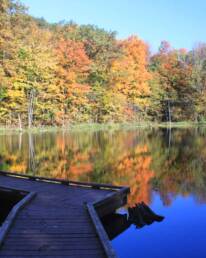
Day Two
MORNINGEXPLORE GLEN WILLIAMS PARK
The History of the hamlet known as Glen Williams is intertwined with that of Georgetown.
In 1825, United Empire loyalist Benajah Williams arrived in the area which would become Halton Hills. Benajah was the brother-in-law of George Kennedy, and like his relation, he was industrious and established several mills.
Glen Williams, small as it was, had to be self-sufficient in many respects. If the villagers needed something, they had to make it themselves, so it was with Glen Williams Park. As with its other civic spaces, the locals recognized the need for a gathering place and they cleared the land to create the park in 1964. Now, it’s a favourite of residents in which to enjoy the fresh air and catch the occasional softball game.
MORNINGGO FOR A HIKE ON THE CREDIT VALLEY FOOTPATH
DAY 2 – UP FOR A BIT OF A HIKE?
Glen Williams Park gives visitors easy access to the Credit Valley Footpath via the Ainley Trail access point. After a detour through the meadows in the Glen community, explore the area around the Credit River, which is teeming with vegetation and wildlife.
The Wendat and Mississaugas were the first people to explore the area’s ridges, plains, and rivers, using the Credit River to facilitate trade and transportation. When European settlers arrived, they tapped the river’s current to power mills for several industrial purposes. On your hike, you may spot the ruins of the Barber Mill, which was built in 1854 and was shuttered a century later.
For Ontario Culture Days 2019, the First Steps along the Path’ Celebration took place here. The program received a Spotlight Recognition Award for showcasing a unique set of activities capturing the themes of well-being, local heritage, and Indigenous history. Programming highlights included an Indigenous Water Ceremony, interactive arts activities, themed trail walks and tasting traditional Indigenous cuisine.
MORNINGVISIT WILLIAMS MILL ART CENTRE
DAY 2 – THE WILLIAMS MILL CREATIVE CENTRE BEGAN AS A SAWMILL, BUILT BY BENAJAH WILLIAMS IN 1825.
The structure was rebuilt in 1852 and then repurposed several times⎯⎯it became a hosiery factory, an electrical facility, and a fruit processing factory. Now, it’s a hub for artists.
The Mill is a collection of artist studios that are open to the public. The artists run regular classes on life drawing, sculpture, music and more. Be sure to check out Glen Williams Glass to watch glass artists at work, and look out for community events and celebrations held at the space.
If you’re hungry, grab some lunch at the Copper Kettle, which is a short walk away. You’ll also find options for sushi, pasta, burgers and pancakes in the area.
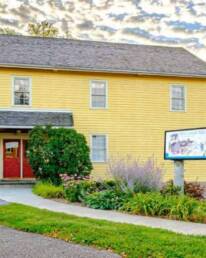
AFTERNOONHERITAGE TOUR OF TOWN
DAY 2 – THE FINAL LEG OF YOUR JOURNEY STARTS AT GLEN WILLIAMS TOWN HALL.
The final leg of your journey starts at Glen Williams Town Hall. In 1871, local leaders established the gathering to meet the varied needs of this small, tight-knit community. The newly minted building was often rented out for church services, concerts, and the occasional theatre production. Lucy Maude Montgomery, of Anne of Green Gables fame, lived nearby in Norval and staged a few shows here in her day.
Walking from the town hall, explore the area’s heritage homes which date back to the mid-19th century. Explore the Charles Williams House, William-Holt House, the Williams Edge Tool Factory, and the Forester House. They aren’t palatial abodes or massive factories, but these buildings were the beating heart of Glen Williams at the time.
And with that, you’ve completed your bite-sized excursion in Glen Williams. You can explore the other towns and hamlets in the hills or sit on the benches by St. Alban the Martyr Anglican Church and watch the Credit River flow.
YOUR TRIP AT A GLANCE
YOUR TRIP AT A GLANCE
This guide represents a weekend-long experience, highlighting one of the many wonderful destinations in the area. To suggest a destination for a future guide, please contact us.
All editorial decisions were made at the sole discretion of Ontario Culture Days staff. This guide was written by Li Robbins.



